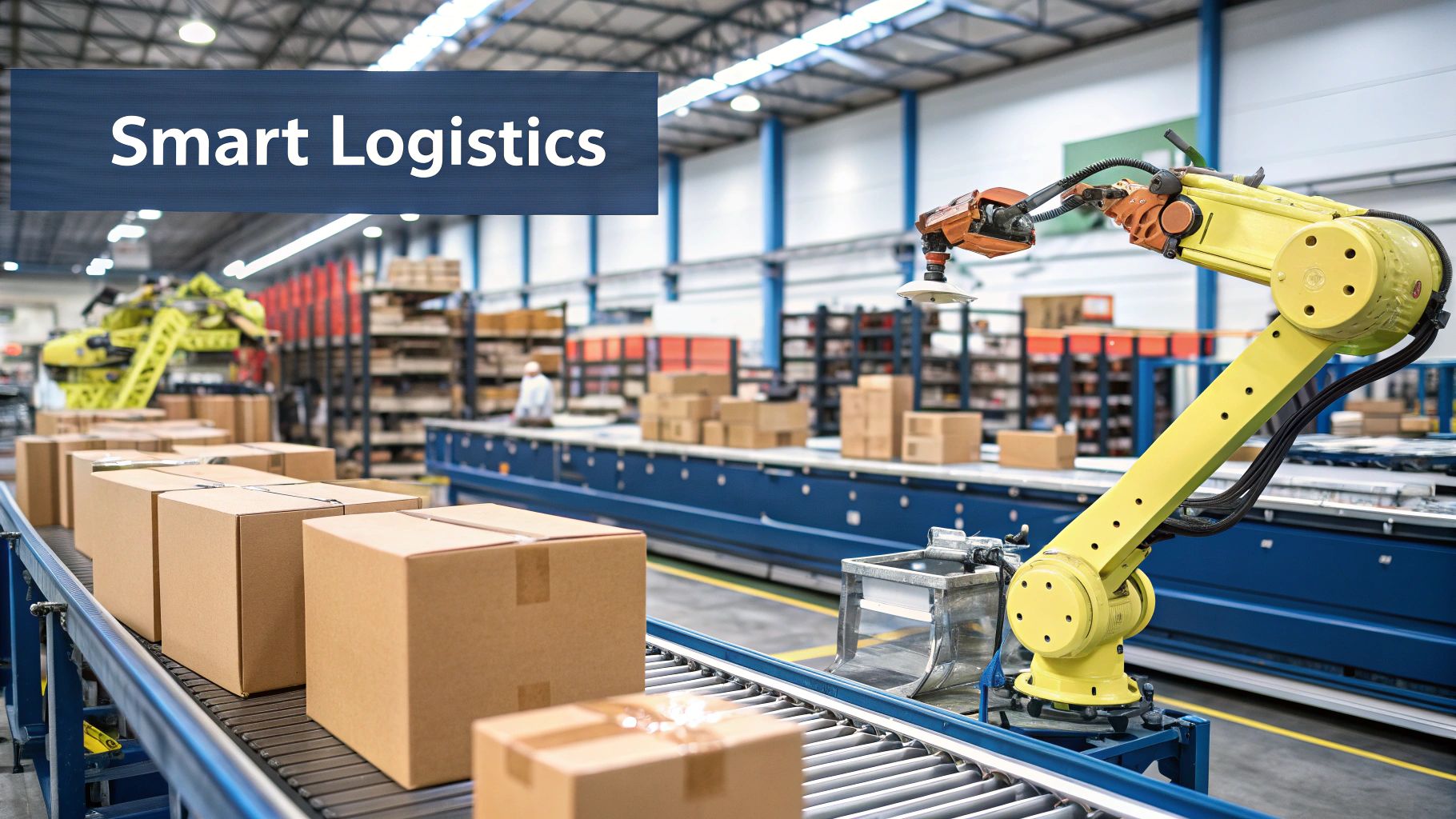10 Game-Changing Business Process Automation Examples That Drive Growth
The Evolution of Business Process Automation

Business process automation (BPA) has come a long way from its early days of basic task automation. The field has shifted from simply automating individual tasks to taking a strategic view of entire workflows. While early automation focused on simple things like spreadsheet macros, modern BPA connects multiple systems to improve operations across entire departments.
Organizations are seeing real benefits - HR teams are processing paperwork faster, finance departments are closing books more efficiently, and customer service teams are responding to inquiries more quickly. This progress stems from both better technology and businesses' growing need to work smarter.
From Basic Task Automation to Intelligent Processes
BPA has evolved through several key stages. It began with basic task automation - think automatic email responses and data entry. This gave way to workflow automation, where connected tasks work together, like purchase order approvals flowing automatically through multiple approvers.
Today, we're entering the era of intelligent automation. By combining artificial intelligence and machine learning, companies can now automate complex processes that require decision-making. For example, AI analyzes customer data to create personalized marketing campaigns and predicts when equipment needs maintenance. This helps businesses not only work faster but also make better decisions.
Driving Forces Behind BPA Adoption
Several practical factors are pushing more companies to adopt BPA. First is the clear need for increased efficiency - by automating routine work, employees can focus on tasks that need human creativity and judgment. BPA also helps reduce mistakes since automated systems are more consistent than manual processes.
The growing availability of user-friendly, affordable automation software has made it easier for companies of all sizes to get started. The numbers tell a compelling story: the robotic process automation (RPA) market hit $1.23 billion** in 2021 and is expected to reach **$12.22 billion by 2029. Already, 53% of organizations use RPA, with another 19% planning to start within two years. Manufacturing leads adoption at 35%. For more details, check out these RPA statistics and trends.
The Future of Business Process Automation
Looking ahead, hyperautomation represents the next frontier. This approach combines RPA, AI, machine learning and other advanced technologies to tackle even the most complex business processes. Tasks that once required human cognitive skills - like analyzing unstructured data or making predictions - can now be automated.
This shift will help companies become more agile and data-driven in their operations. As businesses adopt these advanced automation capabilities, they'll be better positioned to adapt quickly to market changes while keeping their focus on innovation and customer relationships.
Manufacturing Automation Success Stories: From Assembly Line to Smart Factory

Manufacturing has made giant strides in automation, progressing from basic assembly lines to advanced smart facilities. Companies are achieving remarkable improvements in efficiency, quality, and cost reduction through these new technologies. Let's explore some real success stories of manufacturing automation in action.
Robotics Transforming Production Lines
Robotic systems have become essential players on modern production floors. These machines handle repetitive tasks like welding, painting, and assembly with incredible precision and speed - often surpassing human capabilities. For example, major car manufacturers now use robots to weld car frames and install components, leading to faster production times and more consistent quality. This shift allows workers to focus on skilled tasks like quality inspection and equipment maintenance.
IoT and the Rise of the Smart Factory
The Internet of Things (IoT) has opened new possibilities in manufacturing. By connecting machines to a central network, factories gain immediate insight into their operations. Sensors track equipment performance, monitor inventory, and predict when maintenance will be needed. This creates a smart factory environment where production can quickly adapt to changing demands and prevent costly downtime through early problem detection.
AI-Powered Quality Control: Ensuring Excellence
Artificial intelligence is setting new standards in quality assurance. AI vision systems can spot defects that human eyes might miss, ensuring only top-quality products reach customers. These systems analyze data from multiple sources to identify potential quality issues before they become problems. The result is less waste, higher customer satisfaction, and more consistent output.
The push toward automation shows no signs of slowing down. The industrial automation market reached $196.6 billion** in 2021 and is expected to grow to **$412.8 billion by 2030, with a CAGR of 8.59%. Learn more about these trends in this detailed report here. These success stories demonstrate how automation helps create more efficient, reliable, and adaptable manufacturing operations.
Financial Process Automation: Beyond Basic Bookkeeping
Modern finance departments are discovering that automation can dramatically improve their operations. While basic bookkeeping automation is valuable, the real potential lies in transforming entire financial workflows with smart technology. From processing invoices to conducting complex analysis, automation is reshaping how finance teams work.
Automating Core Financial Tasks
The repetitive nature of many financial tasks makes them perfect candidates for business process automation (BPA). Take invoice processing as an example - manually entering invoice data is slow and error-prone. With automation software, teams can process invoices faster and more accurately.
Here are some key financial processes ready for automation:
- Purchase order generation: Create POs automatically based on inventory levels and predefined rules
- Reconciliation: Match bank transactions and spot discrepancies automatically
- Expense reports: Speed up submission, approval and reimbursement workflows
- Payroll processing: Calculate and distribute payments while ensuring compliance
Advanced Financial Automation with AI and Machine Learning
Forward-thinking finance teams are now combining Artificial Intelligence (AI) and Machine Learning (ML) with basic automation. These technologies can handle complex tasks that used to require human judgment.
AI systems can analyze past financial data to forecast future trends and guide budgeting decisions. ML algorithms excel at detecting unusual patterns in transactions that might indicate fraud or errors. By integrating AI and ML capabilities, finance professionals can focus more time on strategic planning and analysis.
Evaluating and Implementing Financial Automation
Success with financial automation requires careful planning and clear goals. Start by evaluating potential projects and calculating the Return on Investment (ROI). For example, a $150,000 investment in automated invoice processing with $30,000 yearly maintenance could save $150,000 annually through reduced labor, fewer errors, and productivity gains - delivering 87.5% ROI over three years. Learn more about measuring automation ROI here.
When choosing automation projects, focus on processes that are:
- High-volume and repetitive
- Prone to errors
- Time-consuming
- Strategically important
With thoughtful evaluation and implementation, finance teams can use automation to work more efficiently, reduce mistakes, and make better strategic decisions.
Customer Service Automation That Actually Delights Customers

Getting customer service right is essential for any business. While automation can improve efficiency, maintaining authentic human connections is just as important. Companies need to carefully choose which processes to automate to make experiences better, not worse.
Automating Responses with Chatbots and Email
Many businesses now use chatbots as their first line of customer support. These digital assistants handle common questions, provide shipping updates, and walk customers through basic problems. This gives human agents more time to tackle complex issues that need a personal touch. Automated emails also keep customers informed with order confirmations, delivery notifications, and relevant recommendations.
AI-Powered Platforms: Making Every Interaction Count
AI technology has opened up new possibilities for better customer service. Smart platforms analyze customer history to provide more relevant help. They can spot potential issues before they happen, suggest solutions based on past cases, and connect customers with the best agent for their specific problem. This focused approach leads to happier customers and more productive support teams.
Recent data shows more companies adopting these tools. 31% of businesses have completely automated at least one department, while 66% of business leaders are testing automation solutions. For more details, check out these business automation statistics.
Striking the Right Balance: Automation and the Human Touch
While automation brings clear benefits, person-to-person contact remains vital. Customers often need empathy and understanding, particularly with sensitive or complicated issues. The most successful companies use automation for routine tasks while keeping skilled human agents ready for situations that need a personal connection.
Measuring Success: Beyond Response Times
To truly understand if automation is working, companies need to look beyond basic metrics like response speed. Key indicators include customer satisfaction ratings, how many issues get fully resolved, and what percentage of problems can be handled automatically. Regular customer feedback about their experiences with automated systems helps companies keep improving. This complete view ensures automation truly helps both customers and the business.
HR Automation: Making Talent Management More Effective
HR teams are finding new ways to improve their work through business process automation. By automating routine tasks, HR professionals can dedicate more time to what matters most - developing company culture and supporting employees. This shift is creating better experiences for everyone involved in HR processes.
Better Recruitment and Onboarding
Finding and bringing on new employees typically takes significant time and effort. However, modern tools help speed up these processes considerably. For instance, automated recruitment platforms can quickly review resumes, match candidates to job requirements, and handle interview scheduling. This frees up HR staff to focus on meaningful candidate interactions.
The onboarding experience also becomes smoother with automation. Digital systems can provide new hires with welcome materials, track their progress through orientation, and collect required paperwork - all while creating a great first impression. This organized approach helps employees feel prepared and welcomed from day one.
Improving Performance Reviews
Performance management becomes more consistent and data-driven with automated tools. These systems help track employee goals, gather feedback, and highlight areas where people can grow. For example, automated check-ins between managers and team members create regular communication channels. As a result, employees receive ongoing support and guidance to help them succeed.
Making Smart Decisions with Data
Beyond task automation, HR systems provide valuable insights about workforce trends. HR analytics tools can measure important metrics like employee retention, hiring timelines, and training results. This helps HR teams spot problems early and make informed choices about talent strategies. With concrete data backing their decisions, HR becomes a stronger strategic partner in the organization.
Keeping the Personal Touch
While automation brings many benefits, the human side of HR remains essential. These tools work best when they support rather than replace personal connections. The key is finding the right mix - using automation for repetitive work while preserving face-to-face interaction for sensitive discussions and relationship building. This balanced approach lets companies gain efficiency while maintaining a caring workplace culture.
Building Your Automation Roadmap: Implementation Strategies and Future Trends

Creating an effective business automation strategy requires careful planning and a clear implementation roadmap. The key is finding the right balance between automating routine tasks while preserving human expertise where it matters most. Let's explore practical approaches for building your automation strategy and examine what's on the horizon.
Choosing the Right Processes for Automation
Not every business process is a good fit for automation. Tasks that follow clear rules and repeat frequently tend to be ideal candidates - like processing invoices or entering data. On the flip side, work requiring complex judgment calls or creative thinking often needs a human touch.
When evaluating processes for automation potential, consider these key factors:
- Frequency: More frequent processes typically deliver better returns on automation investment
- Complexity: Simple, straightforward processes are easier to automate effectively
- Volume: High-volume tasks involving lots of data benefit most from automation
- Error Rates: Processes prone to human mistakes can see major quality improvements through automation
Managing Change and Ensuring Adoption
Adding automation means changing how people work, so managing that transition is critical. Clear communication about how automation will help employees do their jobs better - not replace them - builds buy-in. Providing proper training and ongoing support also helps teams adapt smoothly to new automated workflows.
Integrating Technology for Seamless Automation
The right technology foundation makes automation much more effective. Consider whether cloud-based or on-premise solutions fit your needs best. Check that any automation platforms work well with your existing software and systems. Planning technology integration carefully prevents disruption and helps you get more value from automation investments.
Future Trends in Business Process Automation
The automation field keeps evolving in exciting ways. Here are some key developments to watch:
- Hyperautomation: Combining RPA, AI and machine learning to handle increasingly complex processes
- AI-Powered Decision Making: Smart algorithms analyzing data to guide automated workflow decisions
- Focus on Employee Experience: Using automation to eliminate tedious work so people can focus on more meaningful tasks
Want to see how automation can transform your document workflows? Whisperit, an AI-powered dictation and editing platform, helps professionals create and manage documents up to two times faster. With enterprise-grade security including Swiss hosting, encryption, and GDPR/SOC 2 compliance, Whisperit keeps your sensitive information safe. Check out Whisperit to learn more about modernizing your document processes.